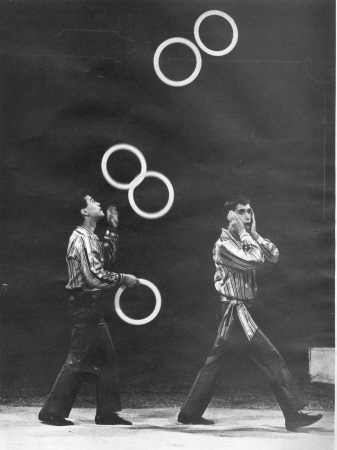
Surprised? Not really! Strinka with a five ring drop back to Felker. |
Page 13 Summer 1986
|
Strinka
considers the job a big step up for his career nonetheless. The pay
is better than he's ever made and the circus represents an entree to
the international juggling arena. Felker refuses to rank the street
and stage according to value. "To me it isn't a step up, just
like it wouldn't be a step down if I went back on the streets where
I started. There are tremendous artists both places," he
said.
Their
current act doesn't represent the limit of their capabilities, but
includes tricks they consider perfectly reliable. "We
practiced passing 11 rings until we got 100 throws, and even got 15
throws from each hand with 12 the one day we practiced that,"
Felker said. "But in the act we just want to be consistent with
ten."
Their
first show as a duo was live in front of more than six million people.
That was in Chile last December for the nationwide television
program, "Martes 13."
The
two met originally in 1977 in Arizona. Strinka lived there and
Felker was in school at Arizona University. Strinka had just learned
to juggle and had never seen anyone do much with the skill until he
and Felker began meeting to practice. "He was amazing,"
Strinka said. "I had never seen anyone that good in
person."
They
parted ways when Felker moved to Boulder, Colorado. Strinka went to
college for a year, but quit because, "I was doing more
juggling than studying." He worked with the Circus Arts Troupe
for two seasons, then moved to Boulder himself in August 1981
because it was home to good jugglers like Felker, Airjazz and John
Leffmgwell. For more than three years he worked the streets and odd
jobs in that region, including some fairs with Sean McMahon.
Felker
returned from his third Globetrotters tour in April 1983. He
toured.Asia for Jugglebug, then decided to work with Strinka. They
worked up and act and sent out publicity material worldwide. They
didn't have to wait long for calls from agents offering work.
The
decision to team up with Strinka represents a turning point in
Felker's career. He worked hard to become a successful solo juggler
and had tremendous ambitions in
that regard. "There was a time when becoming the greatest
juggler in the world was important to me," he confessed.
"It was a hard lesson for me to learn that there were
limitations to my skills with numbers. I learned to do a couple
hundred throws with seven rings and balls, but being honest with
myself I couldn't say it felt natural. I realized it just wasn't
going to happen, so I decided to work on other things -
entertainment and the experience of travel. "
Following their premier on the Chilean television show, they worked at the International Casino in Nairobi, Kenya, for the month of December 1985. Then it was off to Switzerland to work at Chez Maxim, the best nightclub in Geneva. The Big Apple Circus was the next concern to recognize their talent and sign them for a tour. As for the future, Dynamotion expects to continue working in international casinos and nightclubs. Felker would certainly not mind a European circus, either. |

Surprised? Not really! Strinka with a five ring drop back to Felker. |